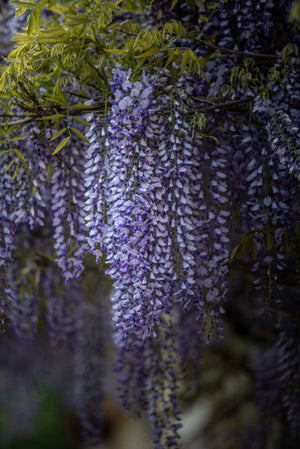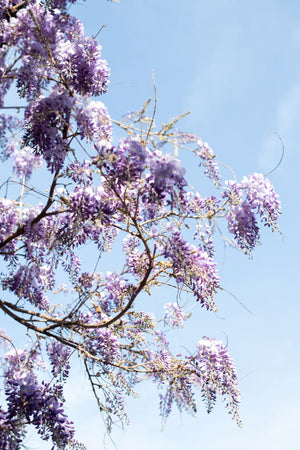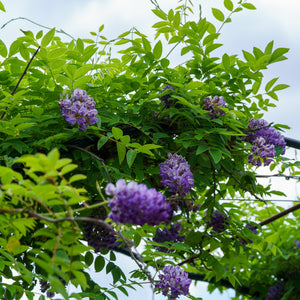The Wisteria Guide
Wisteria, with its cascading blooms and enchanting fragrance, stands as a captivating presence in any garden. Known for its ability to transform spaces into breathtaking displays of color and elegance, Wisteria vines have become cherished additions to landscapes around the world. With gracefully hanging clusters of flowers in shades of purple, blue, pink, or white, Wisteria creates a stunning focal point that evokes a sense of romance and charm. Whether adorning arbor trellises, climbing walls, or enhancing pergolas, Wisteria is a symbol of beauty, grace, and timeless allure in outdoor spaces. Explore the wonders of this mesmerizing vine as we delve into the world of Wisteria and unlock the secrets to cultivating its magical presence in your garden.
About
Wisteria, a genus renowned for its cascading blooms and enchanting presence, graces gardens with a spectacular display of floral beauty. This woody climbing vine, belonging to the Fabaceae family, is celebrated for its vigorous growth, aromatic blossoms, and the ability to transform any outdoor space into a haven of elegance.
Wisteria comprises several species, with Wisteria sinensis (Chinese Wisteria) and Wisteria floribunda (Japanese Wisteria) being among the most popular. Known for their pendulous clusters of fragrant flowers, Wisteria varieties offer a diverse color palette, including shades of purple, blue, pink, and white. The iconic elongated racemes, gracefully hanging from arching vines, create a captivating spectacle during the blooming season.
The cultural significance of Wisteria is deeply rooted in various traditions, symbolizing beauty, romance, and the enduring cycle of life. In many cultures, the vine is associated with longevity and the ability to overcome challenges, making it a meaningful addition to gardens and landscapes.
Wisteria's adaptability to different climates and soil types makes it a versatile choice for gardeners. Thriving in well-drained soil and partial to full sunlight, Wisteria showcases its full potential with proper care. The rapid growth of this vine allows it to quickly cover arbors, pergolas, and trellises, providing a lush green backdrop that transforms into a cascade of blossoms in the flowering season.
Wisteria's beauty is not confined to a single season. Beyond the stunning bloom in spring to early summer, the vine undergoes seasonal transformations. Fresh green foliage adorns the structure in summer, contributing to the overall lushness of the garden. As autumn arrives, Wisteria may offer a second flush of blooms, and the leaves take on warm hues before gracefully falling, leaving behind a sculptural winter silhouette.
Integrating Wisteria into your garden design opens a realm of possibilities. Whether trained to climb structures, create floral arches, or sprawl along fences, the vine adds a vertical dimension to the landscape. Its ability to provide shade and privacy, coupled with the aromatic and visually striking flowers, makes Wisteria a standout feature in various garden styles.
Embark on a journey with Wisteria, and let its cascading blooms become the living notes in the melody of your garden. From spring's initial bud break to the lush foliage of summer and the occasional rebloom in autumn, Wisteria ensures that your outdoor space remains a perpetual masterpiece, resonating with the timeless charm of nature.
Planting
Wisterias, known for their enchanting cascades of blossoms, demand careful attention during the planting phase to ensure their vigorous establishment and continuous flourishing. Below, we outline essential guidelines for planting and maintaining wisterias:
Soil: Wisterias flourish in well-draining soil that is rich in organic matter. They thrive in a slightly acidic to neutral soil with a pH range between 6.0 and 7.0. To create an ideal planting environment, prepare the soil by loosening it and incorporating generous amounts of compost or organic matter. This enhances drainage, promotes fertility, and establishes a nutrient-rich foundation for the wisteria.
Sunlight: Wisteria plants are sun-loving but can tolerate partial shade. When selecting a planting location, prioritize areas that receive at least six hours of direct sunlight daily. In regions with intense heat or dry climates, wisterias can adapt to partial shade, showcasing their versatility in varying environmental conditions.
Watering: Consistent and adequate watering is paramount, especially during the initial stages of wisteria establishment. Immediately after planting, deeply water the plant, and maintain regular irrigation throughout the first year. Adjust the watering frequency to achieve deep and thorough watering once or twice a week, considering rainfall and soil moisture levels. Caution against overwatering, as excessive moisture can lead to root rot.
Mulching: Apply a layer of organic mulch around the wisteria's base for multiple benefits. Mulch helps retain soil moisture, suppress weed growth, and regulate soil temperature. Utilize materials like wood chips, bark, or compost as mulch, maintaining a gap of several inches between the mulch and the trunk to prevent excessive moisture accumulation.
Pruning: Wisterias generally require significant pruning to maintain their desired shape and encourage abundant flowering. Focus on removing any dead, damaged, or tangled branches. The optimal time for pruning is during late winter or early spring, when the plant is dormant, just before new growth emerges. This minimizes stress on the wisteria and promotes robust development.
By following these fundamental planting and care guidelines, you can facilitate the successful establishment and vibrant growth of your wisteria plants. These practices contribute to the long-term health and beauty of your outdoor space, allowing wisterias to thrive and adorn your landscape for years to come.

Care
Wisterias, with their captivating elegance, require specific care practices to ensure their optimal growth and lasting vitality. Here are comprehensive guidelines for the care of wisterias, ensuring they adorn your garden with enduring beauty:
Watering: Provide moderate and consistent watering during the growing season for your wisterias. Aim for approximately one inch of water per week, adjusting based on natural rainfall. It's crucial to water deeply and thoroughly to encourage robust root development. Avoid shallow watering, as it may induce stress and dehydration. In periods of drought or elevated temperatures, additional watering may be necessary to maintain adequate soil moisture.
Pruning: While wisterias generally require minimal pruning, selective care enhances their overall health and aesthetic appeal. Remove any dead or damaged branches to preserve the plant's vitality and appearance. Shaping can be employed to achieve the desired size and form. Pruning is best done during late winter or early spring, before the onset of new growth. Utilize clean, sharp pruning tools to minimize the risk of harm to the plant. Deadheading spent flowers can stimulate new growth and potentially trigger a second blooming, contributing to a prolonged flowering season.
Fertilizing: Fertilization is pivotal in promoting vibrant growth and abundant flowering in wisterias. Apply a balanced, slow-release fertilizer in the spring or early summer, adhering to the recommended application rates and timing specified by the manufacturer. Exercise caution to avoid over-fertilizing, as it can negatively impact the plant's root system. When uncertain, opt for a conservative approach and use less fertilizer, ensuring the health and longevity of your wisterias.
Soil and Sunlight: Wisterias thrive in well-drained, moist soil and revel in full exposure to sunlight. While they exhibit tolerance to diverse soil types, ensuring optimal drainage is essential for their well-being. Mulching around the base of the plant contributes to moisture retention and regulates soil temperature, creating a conducive environment for healthy growth.
Pests and Diseases: Although generally resilient, wisterias can face challenges from pests like aphids, borers, and leaf miners. Vigilance is key—monitor your plants for signs of damage or disease. Swift action with appropriate insecticides or fungicides, when necessary, will help safeguard the health and vitality of your wisterias.
By adhering to these holistic care guidelines, your wisterias will flourish, becoming a perennial source of beauty, shade, and majesty in your garden for many years to come.

How To Use
Wisteria, with its graceful cascades of blossoms, presents a myriad of possibilities to enhance the beauty of your landscape. Unlock its full potential with these insightful recommendations:
Arboreal Elegance: Make a bold statement by featuring wisteria as a captivating focal point in your garden. Plant a cluster of these enchanting vines in an open area to showcase their elegant draping form and cascading flowers. Alternatively, mix and match different wisteria varieties for a diverse display that evolves in breathtaking splendor throughout the seasons.
Vivid Borders: Define the boundaries of your garden with the captivating beauty of wisteria. Their vigorous climbing habit makes them ideal for creating borders that add a touch of romance to your outdoor space. Allow them to weave a tapestry of color and texture along fences, trellises, or walls, transforming these boundaries into living works of art.
Vertical Gardens: Elevate your garden's aesthetics by using wisteria to create stunning vertical gardens. Train these vines to climb on structures like pergolas or arbors, turning functional elements into enchanting focal points. Regular pruning helps maintain control and enhances the visual impact of these vertical displays.
Potted Elegance: Embrace creative container gardening by cultivating wisteria in large pots or containers. This allows you to move these captivating vines to different areas, adding bursts of color to patios, decks, or even balconies. Experiment with various container sizes and shapes to customize your outdoor space and create a portable masterpiece.
Complementary Companions: Harness the beauty and versatility of wisteria by using them as complementary plants. Their cascading flowers and lush foliage complement a variety of other plants. Integrate wisteria into mixed borders or pair them with perennials to create visually pleasing and ecologically supportive plant communities.
Whether you're aiming for a striking focal point, a vibrant border, a vertical garden, or a potted masterpiece, wisteria brings elegance and versatility to your landscape. Consider their climbing nature, breathtaking blooms, and adaptability when planning your garden. With wisteria, you're not just gardening; you're crafting a living masterpiece that evolves with the seasons, adding a touch of enchantment to your outdoor sanctuary.
Conclusion
Wisteria, a captivating cascade of blossoms in the realm of landscaping, stands as a versatile and enchanting vine, offering a visual symphony of colors, forms, and practical uses for your outdoor haven. With its graceful tendrils and adaptability, wisteria adds a touch of timeless beauty to diverse garden settings. As you compose the narrative of your garden, wisteria contributes to the tale with its flowing blooms and intricate vines. From the abundance of spring blossoms to the lush greenery of summer and the warm hues of fall, wisteria creates a living tapestry that unfolds with the changing seasons, ensuring your landscape remains an ever-evolving work of art.
Beyond their visual allure, wisterias play multifaceted roles in your outdoor sanctuary. Whether employed as a cascading focal point, an alluring border, a blooming vertical garden, or a potted masterpiece, these vines seamlessly blend aesthetics with practicality. Crafting privacy, defining spaces, and enhancing the allure of your garden, wisterias exemplify that beauty can indeed serve a purpose.
A testament to their versatility, wisterias make excellent companions to a variety of plants. Their ability to thrive in mixed borders or complement other perennials showcases their compatibility in diverse plant communities. With wisterias as part of your garden ensemble, you're not just cultivating plants; you're fostering a harmonious ecosystem.
Embrace the ever-changing melody of your garden with wisterias as key players. Their resilience and ability to adapt ensure that your landscape remains dynamic, responding to the rhythm of the seasons. By incorporating wisterias, you're creating an outdoor space that resonates with life, color, and the subtle charm of nature.
In the realm of garden design, wisterias are not just vines; they are living notes in the melody of your landscape. With thoughtful planting, care, and creative deployment, these versatile vines can be the crescendo that elevates your outdoor space to a masterpiece. Nurture your garden with the dedication it deserves, and let wisterias be the timeless refrain that brings you joy for years to come.

